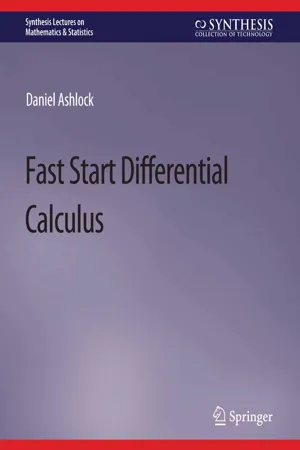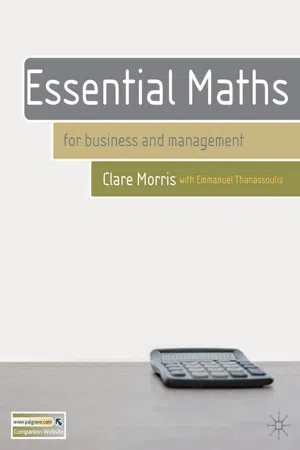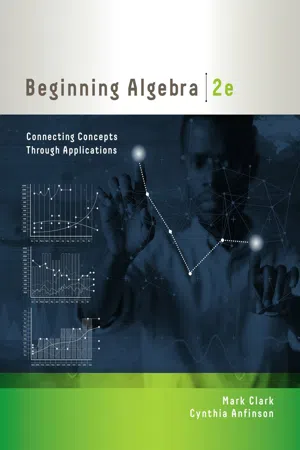Mathematics
Equations
Equations are mathematical statements that assert the equality of two expressions. They typically contain variables, constants, and mathematical operations. Solving an equation involves finding the values of the variables that make the equation true. Equations are fundamental in various mathematical fields, including algebra, calculus, and physics, and are used to model and solve real-world problems.
Written by Perlego with AI-assistance
Related key terms
1 of 5
8 Key excerpts on "Equations"
- eBook - PDF
- Dale Ewen(Author)
- 2018(Publication Date)
- Cengage Learning EMEA(Publisher)
For more information, please visit www.cengage.com and access the Student Online Resources for this text. CHAPTER 6 OBJECTIVES ◆ Use the addition, subtraction, multiplication, and division properties of equality to solve simple Equations. ◆ Solve Equations with parentheses. ◆ Solve Equations with fractions. ◆ Translate words into algebraic symbols. ◆ Solve application problems using Equations. ◆ Solve a formula for a given letter. ◆ Substitute data into a formula and find the value of the indicated letter using the rules for working with measurements. ◆ Substitute data into a formula involving reciprocals and find the value of the indicated letter using a scientific calculator. Equations and Formulas sima/Shutterstock.com Diesel Technician Diesel technician repairing a diesel engine 222 CHAPTER 6 ◆ Equations and Formulas Equations 6.1 In technical work, the ability to use Equations and formulas is essential. A variable is a sym-bol (usually a letter of the alphabet) used to represent an unknown number. An algebraic expression is a combination of numbers, variables, symbols for operations (plus, minus, times, divide), and symbols for grouping (parentheses or a fraction bar). Examples of alge-braic expressions are 4 x 2 9, 3 x 2 1 6 x 1 9, 5 x (6 x 1 4), 2 x 1 5 2 3 x An equation is a statement that two quantities are equal. The symbol “ 5 ” is read “equals” and separates an equation into two parts: the left member and the right member. For example, in the equation 2 x 1 3 5 11 the left member is 2 x 1 3 and the right member is 11. Other examples of Equations are x 2 5 5 6, 3 x 5 12, 4 m 1 9 5 3 m 2 2, x 2 2 4 5 3( x 1 1) To solve an equation means to find what number or numbers can replace the variable to make the equation a true statement. In the equation 2 x 1 3 5 11, the solution is 4. That is, when x is replaced by 4, the resulting equation is a true statement. - Alan Tussy, Diane Koenig(Authors)
- 2018(Publication Date)
- Cengage Learning EMEA(Publisher)
An equation is a statement indicating that two expressions are equal. All Equations contain an equal symbol 5. An example is x 1 5 5 15. The equal symbol 5 separates the equation into two parts: The expression x 1 5 is the left side, and 15 is the right side. The letter x is the variable (or the unknown). The sides of an equation can be reversed, so we can write x 1 5 5 15 or 15 5 x 1 5. n An equation can be true: 6 1 3 5 9 n An equation can be false: 2 1 4 5 7 n An equation can be neither true nor false. For example, x 1 5 5 15 is neither true nor false because we don’t know what number x represents. An equation that contains a variable is made true or false by substituting a number for the variable. If we substitute 10 for x in x 1 5 5 15, the resulting equation is true: 10 1 5 5 15. If we substitute 1 for x, the resulting equation is false: 1 1 5 5 15. A number that makes an equation true when substituted for the variable is called a solution; it is said to satisfy the equation. Therefore, 10 is a solution of x 1 5 5 15, and 1 is not. THE LANGUAGE OF ALGEBRA It is important to know the difference between an equation and an expression. An equation contains an 5 symbol; an expression does not. EXAMPLE 1 Self Check 1 Is 25 a solution of 10 2 x 5 35 2 2x? Now Try Problem 19 Evaluate the expression on the left side. Evaluate the expression on the right side. OBJECTIVE 2 Use the addition property of equality. To solve an equation means to find all values of the variable that make the equation true. We can develop an understanding of how to solve Equations by referring to the scales shown on the right. The first scale represents the equation x 2 2 5 3. The scale is in balance because the weights on the left side and right side are equal. To find x, we must add 2 to the left side. To keep the scale in balance, we must also add 2 to the right side. After doing this, we see that x is balanced by 5. Therefore, x must be 5.- eBook - PDF
- R. Gustafson, Jeff Hughes(Authors)
- 2016(Publication Date)
- Cengage Learning EMEA(Publisher)
Any number that satisfies an equation is called a solution or root of the equa- tion. The set of all solutions of an equation is called its solution set. We have seen that the solution set of 3x 2 2 5 10 is h4j. To solve an equation means to find its solution set. There can be restrictions on the values of a variable. For example, in the fraction x 2 1 4 x 2 2 we cannot replace x with 2, because that would make the denominator equal to 0. ©Oliveromg/Shutterstock.com Copyright 2017 Cengage Learning. All Rights Reserved. May not be copied, scanned, or duplicated, in whole or in part. Due to electronic rights, some third party content may be suppressed from the eBook and/or eChapter(s). Editorial review has deemed that any suppressed content does not materially affect the overall learning experience. Cengage Learning reserves the right to remove additional content at any time if subsequent rights restrictions require it. Section 1.1 Linear Equations and Rational Equations 89 Type of Equation Definition Example Identity Every acceptable real number replacement for the variable is a solution. x 2 2 9 5 sx 1 3dsx 2 3d Every real number x is a solution. Contradiction No real number is a solution. x 5 x 1 1 The equation has no solu- tion. No real number can be 1 greater than itself. Conditional Equation Solution set contains some but not all real numbers. 3x 2 2 5 10 The equation has one solution, the number 4. Two Equations with the same solution set are called equivalent Equations. There are certain properties of equality that we can use to transform Equations into equivalent but less complicated Equations. If we use these properties, the result- ing Equations will be equivalent and will have the same solution set. - eBook - PDF
- Daniel Ashlock(Author)
- 2022(Publication Date)
- Springer(Publisher)
1 C H A P T E R 1 Review of Algebra This book is a text on calculus, structured to prepare students for applying calculus to the physical sciences. The first chapter has no calculus in it at all; it is here because many students manage to get to the university or college level without adequate skill in algebra, trigonometry, or geometry. We assume familiarity with the concept of variables like x and y that denote numbers whose value is not known. 1.1 SOLVING Equations An equation is an expression with an equals sign in it. For example: x D 3 is a very simple equation. It tells us that the value of the variable x is the number 3. There are a number of rules we can use to manipulate Equations. What these rules do is change an equation into another equation that has the same meaning but a different form. The things we can do to an equation without changing its meaning include the following. • Add or subtract the same term from both sides. If that term is one that is already present in the equation, we may call this moving the term to the other side. When this hap- pens, the term changes sign, from positive to negative or negative to positive. For example: x 4 D 5 This is the original equation x D 5 C 4 Add 4 to both sides (move 4 to the other side) x D 9 Finish the arithmetic • Multiply or divide both sides by the same expression. 2 1. REVIEW OF ALGEBRA For example: 3x 4 D 5 This is the original equation 3x D 5 C 4 Add 4 to both sides (move 4 to the other side) 3x D 9 Finish the addition 3x 3 D 9 3 Divide both sides by 3 x D 3 Finish the arithmetic • Apply the same function or operation to both sides. For example: p x 2 D 5 This is the original equation p x 2 2 D 5 2 Square both sides x 2 D 25 Do the arithmetic x D 27 Move 2 to the other side Knowledge Box 1.1 The rules for solving Equations include: 1. Adding or subtracting the same thing from both sides. 2. Moving a term to the other side; its sign changes. 3. Multiplying or dividing both sides by the same thing. - eBook - PDF
- Richard Aufmann, Joanne Lockwood, Richard Nation, Daniel K. Clegg(Authors)
- 2017(Publication Date)
- Cengage Learning EMEA(Publisher)
For the variable term 20.02v 2 , 20.02 is the coefficient and v 2 is the variable part. Like terms of a variable expression are terms with the same variable part. Constant terms are also like terms. Examples of like terms are 4x and 7 x 9y and y 5x 2 y and 6x 2 y 8 and 23 An equation expresses the equality of two mathematical expressions. Each of the following is an equation. 8 + 5 = 13 4y - 6 = 10 x 2 - 2x + 1 = 0 b = 7 Each of the Equations below is a first-degree equation in one variable. First degree means that the variable has an exponent of 1. x + 11 = 14 3z + 5 = 8z 2( 6y - 1) = 34 A solution of an equation is a number that, when substituted for the variable, results in a true equation. 3 is a solution of the equation x + 4 = 7 because 3 + 4 = 7. 9 is not a solution of the equation x + 4 = 7 because 9 + 4 ≠ 7. To solve an equation means to find all solutions of the equation. The following prop- erties of Equations are often used to solve Equations. TAKE NOTE Recall that the order of operations agreement states that when sim- plifying a numerical expression you should perform the operations in the following order: 1. Perform operations inside parentheses. 2. Simplify exponential expressions. 3. Do multiplication and division from left to right. 4. Do addition and subtraction from left to right. POINT OF INTEREST One of the most famous Equations is E = mc 2 . This equation, stated by Albert Einstein (n′ stn), shows that there is a relationship between mass m and energy E. In this equation, c is the speed of light. Albert Einstein Archive, Jerusalem, Ferdinand Schmutzer. TAKE NOTE It is important to note the differ- ence between an expression and an equation. An equation contains an equals sign; an expression doesn’t. Copyright 2018 Cengage Learning. All Rights Reserved. May not be copied, scanned, or duplicated, in whole or in part. Due to electronic rights, some third party content may be suppressed from the eBook and/or eChapter(s). - eBook - PDF
- Ron Larson(Author)
- 2021(Publication Date)
- Cengage Learning EMEA(Publisher)
The operations that yield equivalent Equations come from the properties of equality reviewed in Section P.1. Definition of a Linear Equation in One Variable A linear equation in one variable x is an equation that can be written in the standard form ax + b = 0 Standard form where a and b are real numbers with a ≠ 0. Generating Equivalent Equations An equation can be transformed into an equivalent equation by one or more of the steps listed below. Equivalent Given Equation Equation 1. Remove symbols of grouping, 2x - x = 4 x = 4 combine like terms, or simplify fractions on one or both sides of the equation. 2. Add (or subtract) the same x + 1 = 6 x = 5 quantity to (or from) each side of the equation. 3. Multiply (or divide) each 2x = 6 x = 3 side of the equation by the same nonzero quantity. 4. Interchange the two sides of 2 = x x = 2 the equation. © The Print Collector/Alamy This ancient Egyptian papyrus, discovered in 1858, contains one of the earliest examples of mathematical writing in existence. The papyrus itself dates back to around 1650 B.C., but it is actually a copy of writings from two centuries earlier. The algebraic Equations on the papyrus were written in words. Diophantus, a Greek who lived around A.D. 250, is often called the Father of Algebra. He was the first to use abbreviated word forms in Equations. HISTORICAL NOTE Copyright 2022 Cengage Learning. All Rights Reserved. May not be copied, scanned, or duplicated, in whole or in part. Due to electronic rights, some third party content may be suppressed from the eBook and/or eChapter(s). Editorial review has deemed that any suppressed content does not materially affect the overall learning experience. Cengage Learning reserves the right to remove additional content at any time if subsequent rights restrictions require it. 1.2 Linear Equations in One Variable 83 GO DIGITAL EXAMPLE 1 Solving Linear Equations a. 3x - 6 = 0 Original equation 3x = 6 Add 6 to each side. - eBook - PDF
Essential Maths
for Business and Management
- Clare Morris(Author)
- 2007(Publication Date)
- Bloomsbury Academic(Publisher)
77 Solving Equations CHAPTER 5 Intended learning outcomes By the end of your work on this chapter you should: ɀ understand what is meant by an equation and its solution ɀ be able to recognise and solve linear Equations ɀ be able to recognise and solve quadratic Equations using the formula method ɀ be able to solve two simultaneous linear Equations ɀ feel confident in manipulating formulae ɀ understand inequalities and be able to manipulate them correctly ɀ be able to build Equations to represent practical situations, and to interpret their solutions appropriately. Prerequisites Before you start work on this chapter, you should be confident in your understanding of the material of Chapters 3 and 4. 5.1 78 Essential Maths Equations in practice In Chapter 4, we’ve seen a number of examples showing how algebraic expressions can be used to represent practical relationships. Very often, we wish to go further and, rather than just looking at the general relationship, ask what value a variable will have in partic-ular circumstances. Here are two examples, based on problems we’ve already come across in the preceding chapter. Example 1: How much should we charge? In Section 4.3, we developed the relationship n = 520 – 4 p which linked the price in pence of a packet of biscuits with the number of packets sold per week. If the retailer decides that she wishes to sell 200 packets a week, how much should she charge per packet? When 200 packets are sold, n = 200, and so we can replace n in the general relationship by 200, to get 200 = 520 – 4 p . This is an equation which, as we will see, can be solved to tell us the specific value of p required. Example 2: How long will we have to wait? Also in Section 4.3, we built up the expression n = 120 + 20 k to show how the number of visitors per week to a website, n , increases with the number of weeks it’s been operating, k . - eBook - PDF
Beginning Algebra
Connecting Concepts through Applications
- Mark Clark, Cynthia Anfinson(Authors)
- 2018(Publication Date)
- Cengage Learning EMEA(Publisher)
589 © iStock.com/Bike_Maverick I n image processing, photographs must often be made larger or smaller from the original to fit a certain space. This sizing, which is known as scaling , can be analyzed mathematically using proportions. In this chapter, we develop the tools for rational expressions and Equations that allow us to solve applications such as scaling. Rational Expressions and Equations 7 7.1 The Basics of Rational Expressions and Equations 7.2 Multiplication and Division of Rational Expressions 7.3 Addition and Subtraction of Rational Expressions 7.4 Solving Rational Equations 7.5 Proportions, Similar Triangles, and Variation Copyright 2019 Cengage Learning. All Rights Reserved. May not be copied, scanned, or duplicated, in whole or in part. Due to electronic rights, some third party content may be suppressed from the eBook and/or eChapter(s). Editorial review has deemed that any suppressed content does not materially affect the overall learning experience. Cengage Learning reserves the right to remove additional content at any time if subsequent rights restrictions require it. C H A P T E R 7 R a t i o n a l E x p r e s s i o n s a n d E q u a t i o n s 590 Evaluating Rational Expressions and Equations In this chapter, we examine many of the topics from Chapters 5 and 6 and combine them to study rational expressions and Equations . Rational expressions result from dividing two polynomials. Rational expressions show up in many different applications, including finding averages. The Basics of Rational Expressions and Equations LEARNING OBJECTIVES Evaluate rational expressions and Equations. Find excluded values. Simplify rational expressions. 7.1 What’s That Mean? Rational The word ratio in mathematics refers to a quotient of two mathematical elements. A rational number is a ratio of integers, with a nonzero denominator.
Index pages curate the most relevant extracts from our library of academic textbooks. They’ve been created using an in-house natural language model (NLM), each adding context and meaning to key research topics.







